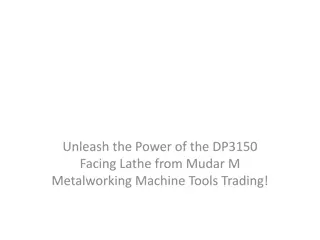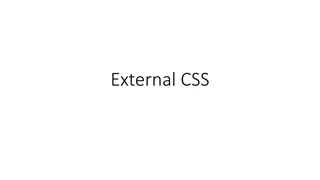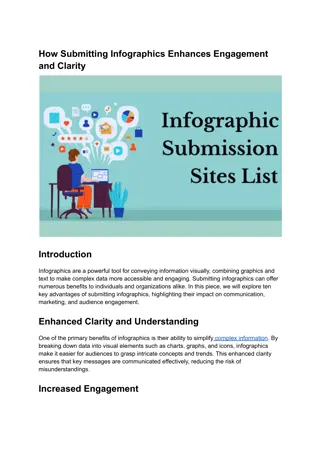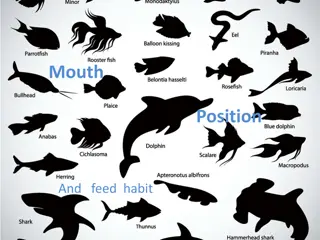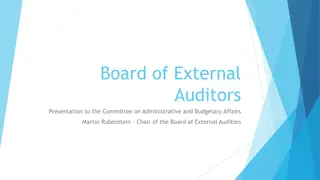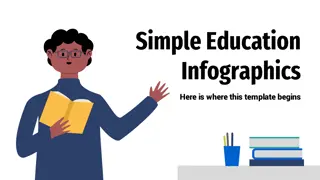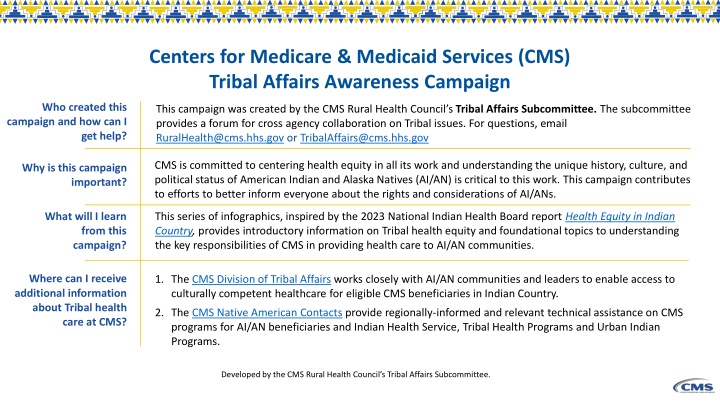
Tribal Health Equity and Sovereignty
This campaign by the CMS Rural Health Council's Tribal Affairs Subcommittee aims to raise awareness about the importance of Tribal health equity and sovereignty. It provides foundational information on key responsibilities of CMS in providing healthcare to American Indian and Alaska Native communities. By exploring topics like Tribal sovereignty, self-determination, and federal trust responsibility, individuals can gain insights into the daily exercise of these rights by Tribes in managing healthcare programs. For additional information on Tribal health care at CMS, contact the Division of Tribal Affairs or the Native American Contacts for regionally-informed assistance.
Download Presentation

Please find below an Image/Link to download the presentation.
The content on the website is provided AS IS for your information and personal use only. It may not be sold, licensed, or shared on other websites without obtaining consent from the author. If you encounter any issues during the download, it is possible that the publisher has removed the file from their server.
You are allowed to download the files provided on this website for personal or commercial use, subject to the condition that they are used lawfully. All files are the property of their respective owners.
The content on the website is provided AS IS for your information and personal use only. It may not be sold, licensed, or shared on other websites without obtaining consent from the author.
E N D
Presentation Transcript
Centers for Medicare & Medicaid Services (CMS) Tribal Affairs Awareness Campaign Who created this campaign and how can I This campaign was created by the CMS Rural Health Council s Tribal Affairs Subcommittee. The subcommittee provides a forum for cross agency collaboration on Tribal issues. For questions, email RuralHealth@cms.hhs.gov or TribalAffairs@cms.hhs.gov get help? CMS is committed to centering health equity in all its work and understanding the unique history, culture, and political status of American Indian and Alaska Natives (AI/AN) is critical to this work. This campaign contributes to efforts to better inform everyone about the rights and considerations of AI/ANs. Why is this campaign important? What will I learn from this campaign? This series of infographics, inspired by the 2023 National Indian Health Board report Health Equity in Indian Country, provides introductory information on Tribal health equity and foundational topics to understanding the key responsibilities of CMS in providing health care to AI/AN communities. Where can I receive additional information about Tribal health care at CMS? 1. The CMS Division of Tribal Affairs works closely with AI/AN communities and leaders to enable access to culturally competent healthcare for eligible CMS beneficiaries in Indian Country. 2. The CMS Native American Contacts provide regionally-informed and relevant technical assistance on CMS programs for AI/AN beneficiaries and Indian Health Service, Tribal Health Programs and Urban Indian Programs. Developed by the CMS Rural Health Council s Tribal Affairs Subcommittee.
4 KEY TERMS TO KNOW American Indian/Alaska Native (AI/AN) Health Equity Basics 01 | Tribal Sovereignty 02 | Self-Determination Tribal sovereignty is the right of each federally recognized Tribe to govern the citizens of its nation, exercise jurisdiction over the Tribe s territory, and to exercise other governmental powers. The protected political status of Tribes and its Tribal members is recognized in treaties, the Constitution, Supreme Court cases, executive orders, and other federal policies and regulations. Self-Determination is the right of Tribes to assume responsibility for programs and services that the federal government would otherwise provide on behalf of its Tribal members, (e.g., contracting with the Indian Health Service for operation of a hospital or health center) under the Indian Self-Determination and Education Assistance Act (ISDEAA) of 1975, enacted by Public Law 93-638. Tribes and Tribal organizations that operate under ISDEAA are often referred to as 638 Tribes. 03 | Self-Governance 04 | Federal Trust Responsibility Federal Trust Responsibility refers to the unique government-to- government relationship that exists between Indian Tribes and the federal government. This relationship is grounded in the U.S. Constitution, numerous treaties, statutes, Federal case law, regulations and executive orders that establish and define a trust relationship with Indian Tribes. Tribal Self-Governance is when Tribes have greater autonomy in the direction, management, and delivery of health programs and services that they provide to their Tribal members, as authorized under Title V of the Indian Self-Determination and Education Assistance Act (ISDEAA). What does it all look like? Tribes exercise their right of Tribal sovereignty, self-determination, and self-governance daily by directing and operating programs that the Federal government would normally operate. For example, Cherokee Elder Care, a Program of All-Inclusive Care for the Elderly (PACE) program, is the only PACE program operated by a Tribe. The Cherokee Nation Comprehensive Care Agency board governs the program as well as facilitating various Cherokee Nation health care initiatives. Developed by the CMS Rural Health Council s Tribal Affairs Subcommittee
Digging Deeper: Tribal Sovereignty Why is Tribal Sovereignty Important to CMS? Tribal Sovereignty is the right of each Tribe to govern the citizens of its nation, exercise jurisdiction over the Tribe s territory, and to exercise other governmental powers. CMS respects and supports the government-to-government relationship that Tribal Nations have with the U.S. federal government. 1 CMS recognizes Tribal sovereignty by working alongside Tribes and building meaningful relationships through the Tribal Technical Advisory Group (TTAG) and Tribal Consultations. 2 What is a Federally Recognized Tribe? Did you know? There are 574 Federally Recognized Tribes in the U.S. There are 197 active indigenous languages in the U.S. Federal recognition formalizes the government-to-government relationship between the U.S. federal government and Tribes. Federally recognized Tribes are eligible for special programs and services provided by the United States and have certain rights and protections. The largest federal Indian reservation is the 16 million-acre Navajo Nation Reservation in Arizona, New Mexico, and Utah. Nearly half (229) are in Alaska Approximately 56.2 million acres are held in trust by the U.S. for various Indian tribes and individuals. Names for Tribal areas include reservations, pueblos, rancherias, missions, villages, communities and more. Developed by the CMS Rural Health Council s Tribal Affairs Subcommittee.
Understanding Tribal Consultation Tribal consultation is a formal, two-way, government to government dialogue required by Executive Order 13175 that emphasizes trust, respect, and shared responsibility between Tribes and federal agencies. OUTCOMES WHO WHAT Tribes provide meaningful and timely input on agency policies and regulations Includes Tribal and federal officials with decision making authority Opportunity to consider and leverage Tribes ideas, concerns, and questions CMS and Tribes have a complete understanding of all factors and implications and agree on how to move forward Applies to any proposed CMS policy or action that has Tribal implications WHEN Initiated at the earliest possible point in policy formulation Open and free exchange of information and opinion between Tribes and CMS CMS communicates with Tribes on how Tribal feedback informed final policy and outcomes Should be a continuous and ongoing conversation Listening sessions held to solicit Tribal viewpoints are considered informal engagement. Listening sessions can provide valuable insight but are not considered, and cannot replace, Tribal consultation. To learn more about Tribal consultation, explore the CMS Tribal Technical Advisory Group (TTAG) recommendations via the CMS TTAG Strategic Plan, 2020- 2025, for strengthening Tribal health policies and guidelines at CMS, including Tribal consultation. Developed by the CMS Rural Health Council s Tribal Affairs Subcommittee.
The Indian Health Service The Indian Health Service (IHS) is the principal federal provider of health services to approximately 2.56 million eligible American Indians/Alaska Natives (AI/ANs). Types of Care Offered Funding About The IHS is a discretionary program that receives congressionally appropriated funds each year. Though this funding has increased over time, it continues to be insufficient to meet the health care needs of AI/ANs. The IHS is not insurance. Medical/ Behavioral Community Health Instead, the IHS provides and supports direct health care services at no cost to eligible AI/ANs through more than 400 facilities, mostly on or near reservations. Dental Pharmacy How do CMS and IHS work together? Did you know? Reimbursement: CMS provides additional funding streams to IHS and Indian health care providers through Medicare, Medicaid, CHIP, and the Marketplace. Medicaid is the IHS s largest third-party payer, providing around $1 billion in reimbursements each year. 1 The estimate to fully fund the IHS is $51.4 billion whereas the 2024 IHS funding is $6.96 billion. Health Coverage: CMS coverage provides greater access to services for AI/ANs that the IHS system might not be able to provide (e.g., specialty surgical services at an outside facility). 2 3 Targeted Outreach: CMS conducts targeted outreach to AI/ANs and enrollment assisters for Medicare, Medicaid, CHIP, and Marketplace coverage. Developed by the CMS Rural Health Council s Tribal Affairs Subcommittee.
Self-Governance: Tribal Provision of Health Care Services Exercising the Right to Self-Governance What is CMS s Role? Under Titles I and V of the Indian Self-Determination and Education Assistance Act, federally recognized Tribes can assume partial or complete control of health care programs previously managed by the Indian Health Service (IHS). Tribes do so by entering into agreements, called compacts and contracts, with the IHS. While CMS does not compact or contract with federally recognized Tribes (called 638 Tribes), Tribal facilities are supported by CMS via reimbursement for services. By paying for services provided to Medicaid and Medicare enrollees at Tribal facilities, CMS is supporting the ability of 638 Tribes to improve the health of American Indians/Alaska Natives (AI/ANs). Did you know that Tribes operate approximately 60% of the health care programs while the IHS manages the rest? *Learn more about milestones in the journey of Tribal self-governance* Self-Governance in Action Members of the Eastern Band of Cherokee Indians exercised their right to self-governance by taking full control over the Cherokee Indian Hospital, formerly managed by IHS. Cherokee Indian Hospital s largest source of funding comes from Medicare and Medicaid reimbursements, followed by the IHS and Tribal contributions. Since taking over, they have: Built a new hospital that acknowledges and pays tribute to the Tribe s traditions and culture. Added a new residential support home and treatment center for Tribal members struggling with mental health or substance use. Adopted an integrated, patient-centered care model tailored to the Tribe s needs. Constructed the Tsali Care Center, a 72-bed senior living facility. Developed by the CMS Rural Health Council s Tribal Affairs Subcommittee.
Roles of the Federal and Tribal Governments in Health Care Services Under the Federal Trust Responsibility, Tribes have a unique government-to-government relationship with the federal government, resulting in a complex network of health services, coverage, and funding for American Indians and Alaska Natives (AI/ANs) across multiple federal agencies and Tribal governments. Coverage & Reimbursement Health Care to AI/ANs CMS and the VHA offer coverage and reimbursement for services received by AI/ANs. Eligible AI/ANs can receive medical care from multiple facilities operated by various federal agencies and Tribes, such as: Reimbursements by CMS and the VHA provide additional funding resources to the IHS, Tribal, and UIO facilities. Additionally, when AI/ANs enroll in CMS administered programs, such as Medicare, Medicaid, CHIP, or the Marketplace, they have greater access to services. The Indian Health Service (IHS) and Veterans Health Administration (VHA) provide health care services to eligible AI/ANs. Self-Governance Tribes and Urban Indian Organizations (UIOs) operate Tribal hospitals and clinics to best serve their communities. Grant Funding ACL, SAMHSA, and HRSA, and other federal agencies provide dedicated grant funding to support health care services for AI/AN communities. Developed by the CMS Rural Health Council s Tribal Affairs Subcommittee.
American Indian and Alaska Native (AI/AN) Health Disparities Culturally Tailored Care AI/AN Health Disparities Explore examples of AI/AN culturally tailored care American Indian and Alaska Native (AI/AN) communities have health disparities rooted in economic adversity and poor social conditions. For example, on average AI/AN people die 12-13 years earlier than their white peers. 1 Culturally Tailored Services As suggested by the CMS Framework for Health Equity (Priority 4), culturally tailored services include healing informed care for AI/AN communities, which is derived from a rich understanding of Indigenous knowledge It provides guidance to those who experience distress individually, in a family, or in a community. like the Alaska Community Health Aide Program, serving Alaska Natives in the Alaska Tribal Health System. Compared to national averages, AI/ANs causes of mortality at higher rates: Understand and support culturally tailored services 2 +207% DIABETES +64% SUICIDE +50% PNEUMONIA & FLU Cultural awareness and cultural respect are critical to reducing health disparities. The National CLAS Standards is a tool to reduce health disparities, promoting the respect of the whole individual and responsiveness to their health needs and preferences. Drug overdose deaths for AI/ANs have increased over the past two decades. In fact, from 2019 to 2020, drug overdose deaths amongst non-Hispanic AI/ANs increased 39%. Developed by the CMS Rural Health Council s Tribal Affairs Subcommittee.
Historical Trauma in Tribal Communities Traditional Healing What is Historical Trauma? Traditional healing refers to Tribal practices and cultural traditions that build resiliency and strengthen community and cultural connections for improved physical, mental, emotional, social, and spiritual health and wellbeing. Historical trauma is multigenerational trauma experienced by a specific cultural, racial, or ethnic group and is related to a major event such as slavery, the Holocaust, forced migration, or the violent colonization of Native Americans. For American Indians/Alaska Natives (AI/ANs), traumas that happened long ago in history by one generation may be lived out and experienced repeatedly by subsequent generations. Unresolved historical trauma may impact physical and behavioral health and can manifest in symptoms like depression, self- destructive behavior, and cardiovascular disease for AI/ANs today. Traditional healing practices play a crucial role in healing from the impacts of historical trauma. Healing from historical trauma requires treatment that is culturally appropriate and tailored to the individual s specific needs. Learn More About Historical Trauma Did you know? In 2024, CMS approved four state section 1115 demonstration amendments in AZ, CA, NM, and OR that allow Medicaid and CHIP coverage of traditional health care practices provided at Indian Health Service facilities, Tribal facilities, and Urban Indian Health Organization facilities. Each facility will credential their healers and develop their programs that will be evaluated by CMCS as part of the demonstration. Consider how the Federal Indian boarding school system has contributed to historical trauma for AI/ANs. 1 Explore the continued impacts of historical trauma on AI/ANs today. 2 Learn more about unresolved trauma and the ongoing effects on AI/AN health equity. 3 Developed by the CMS Rural Health Council s Tribal Affairs Subcommittee.
A diagram with concentric circles representing different aspects of he First Nations Perspective on Health and Wellness. The innermost circle is labeled "Human Being" with four sections labeled "Emotional," "Mental," "Physical," and "Spiritual." Surrounding this is a circle with aspects like "Family," "Wisdom," "Responsibility," and "Community" for Environmental and Cultural dimensions; "Respect," "Relationships," "Land," and "Nations" for Social and Economic dimensions. The outermost layer shows silhouettes of people holding hands, symbolizing unity and interconnectedness. Indigenous Health and Wellness From an indigenous perspective, good health extends beyond the individual and the physical and relates to the ancestral and current community, as well as the natural and spiritual worlds. The First Nations Perspective on Health and Wellness, pictured to the right, depicts a holistic vision of wellness. Examples of indigenous health and wellness practices, as seen in past CMS American Indian/Alaska Native (AI/AN) heritage events: Smudging involves the burning of harvested and dried plant-based medicines and using the smoke to promote holistic wellness. Promoting indigenous foods by prioritizing regional plants and animal life and leveraging traditional food systems. Developed by the CMS Rural Health Council s Tribal Affairs Subcommittee.
CMS Division of Tribal Affairs Resources Division of Tribal Affairs (DTA) Check out a Culturally Sensitive Training on the CMS Division of Tribal Affairs website at Go.CMS.gov/AIAN that outlines examples of culturally-insensitive terms and some alternatives. DTA works across CMS to expand access to coverage and culturally competent health care for eligible American Indian/Alaska Native (AI/AN) enrollees. Works with the Native American Contacts and facilitates agency engagement with the Tribal Technical Advisory Group. Serves as an administrative resource to CMS employees, Tribal entities and others outside of CMS. Reach out to TribalAffairs@cms.hhs.gov for more information. Instead of this, say that! Gone off script, or missing the mark Off the reservation CMS AI/AN Employee Resource Group (ERG) Keep the trains moving, or keep things moving smoothly while we re away Hold down the fort The AI/AN ERG promotes equal opportunities for AI/AN staff and provides educational resources to CMS employees, including a lecture series on community and culture. Energized/spirited or ready to argue On the warpath Rural Health Council Tribal Affairs Subcommittee The CMS Rural Health Council Tribal Affairs Subcommittee consists of members from across the CMS who are invested in advancing Tribal issues. The Subcommittee meets monthly and welcomes all interested CMS employees to join. Present a united front, or band together Circle the wagons Developed by the CMS Rural Health Council s Tribal Affairs Subcommittee.




